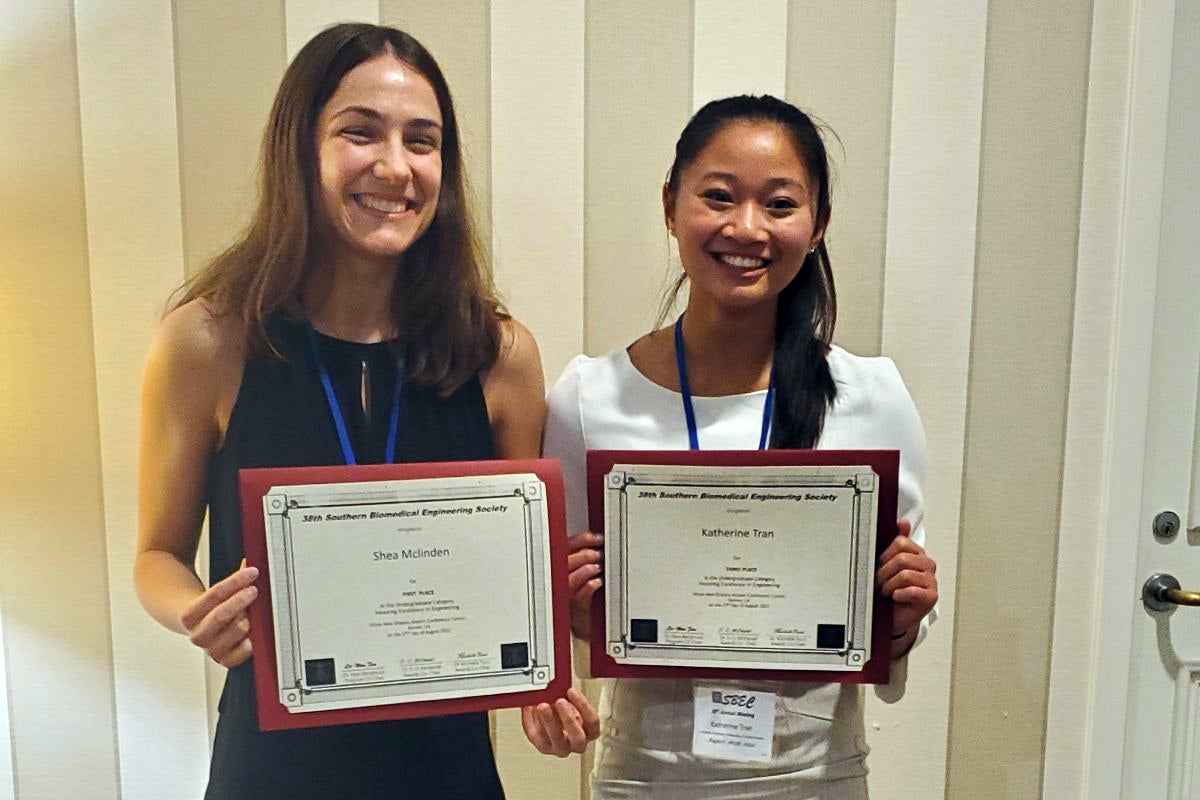University of Central Florida health sciences students recently received top recognition for research presentations illustrating the impact that developed technology and research can make in the lives of people with accessibility limitations.
The research was performed in collaboration with Limbitless leadership and faculty and specifically focused on life improving technology for amyotrophic lateral sclerosis (ALS), and limb differences, such as congenital limb amputations.
The students, Shea McLinden and Katherine Tran, received the recognition at the Southern Biomedical Engineering Conference held recently in New Orleans.
McLinden, a senior, and Tran, a junior, are undergraduate research students at Limbitless Solutions, a nonprofit organization and direct support organization at UCF.
McLinden received first place in the undergraduate category for her presentation on using training video games to improve people’s use of bionic arms and hands-free wheelchairs. Tran received third place in the undergraduate category for her presentation on developing a custom silicone insole orthotic, or foot support, for an individual born with a congenital limb abnormality affecting their foot. The wheelchair game research was funded through a grant from the Pabst Steinmetz Foundation. The undergraduate student research was also supported with funds from the Paul B. Hunter and Constance D. Hunter Charitable Foundation and the Albert E. and Birdie W. Einstein Foundation.
Video Game Training
McLinden presented two oral presentations, both discussing the design and effectiveness of video game training for Limbitless’ bionic arm and hands-free wheelchair project. The projects use Limbitless’ video game-based training that converts muscle flexing through electromyography (EMG) into the game character’s actions. The development of the training game research is led by UCF faculty members Matt Dombrowski ’05 ’08MFA, with UCF’s School of Visual Arts and Design, and Peter Smith ’05MS ’12PhD, with UCF’s Nicholson School of Communication and Media.
McLinden’s presentation, titled “Utilizing EMG And Eye Tracking For Serious Game Control For Populations With Neurodegenerative Diseases,” highlighted new human computer interfaces being developed that leverage eye-tracking in combination with electromyograph (EMG ) sensing muscles contracted in the jaw to control a video game that trains patients to use a patented hands-free wheelchair control system (Limbitless’ Project Xavier) for patients unable to use a traditional joystick, including ALS patients.
The video game training system is designed to train users to operate the wheelchair, with players navigating the game’s interface using only their eyes before practicing the chair’s operation using clenches of their temporalis muscles. Students from a variety of majors work with research staff and faculty for the gamification and development. The accessible interface supports patients learning to control the system in a low-stress and safe environment prior to driving the system.
Continuing patients’ independent mobility is thought to support greater perceived autonomy and dignity throughout disease progression. The EMG and eye-tracking technology will be evaluated in an upcoming research study, building on the results of the prior clinical trial with the Mayo Clinic.
McLinden also presented the team’s research on training efforts to accelerate learning to use a bionic arm, titled “Improvement in Muscle Control via Serious Gaming for Prosthetic Usage.”
McLinden and her fellow research members engaged with UCF students on campus to collect valuable data regarding their participation and perspective for application to improve the training for prosthetic users through gamified simulation using surface EMG.
The surface EMG was attached to the patient’s forearm to discretize their muscular signal into a correlated action within the video game.
“The work is important because prosthesis users often reject their devices due to inability to master them immediately, among other factors including weight of the prosthetic and potential social stigma,” McLinden says.
Developing a Custom Foot Support
Tran’s project was titled “Developing Custom Advanced Orthotic to Improve Biomechanical Gait for Congenital Symbrachydactyly.” The project aimed to develop a non-invasive technique to aid in improving foot stability and minimizing discomfort symptoms in patients with congenital foot abnormalities. The device works to adapt a unique foot shape to a traditional shoe to improve gait and traction. The project involved manufacturing techniques including mold casting, 3D printing and silicon molding.
The work enabled Tran to immerse herself in medical research, patient care, and use hands-on manufacturing tools and techniques.
“Working with the patient was an insightful experience, as I was able to work hands-on to create something special and impactful,” Tran says. “The project has shown me the impact of assistive technology and the greater meaning of my work.”




